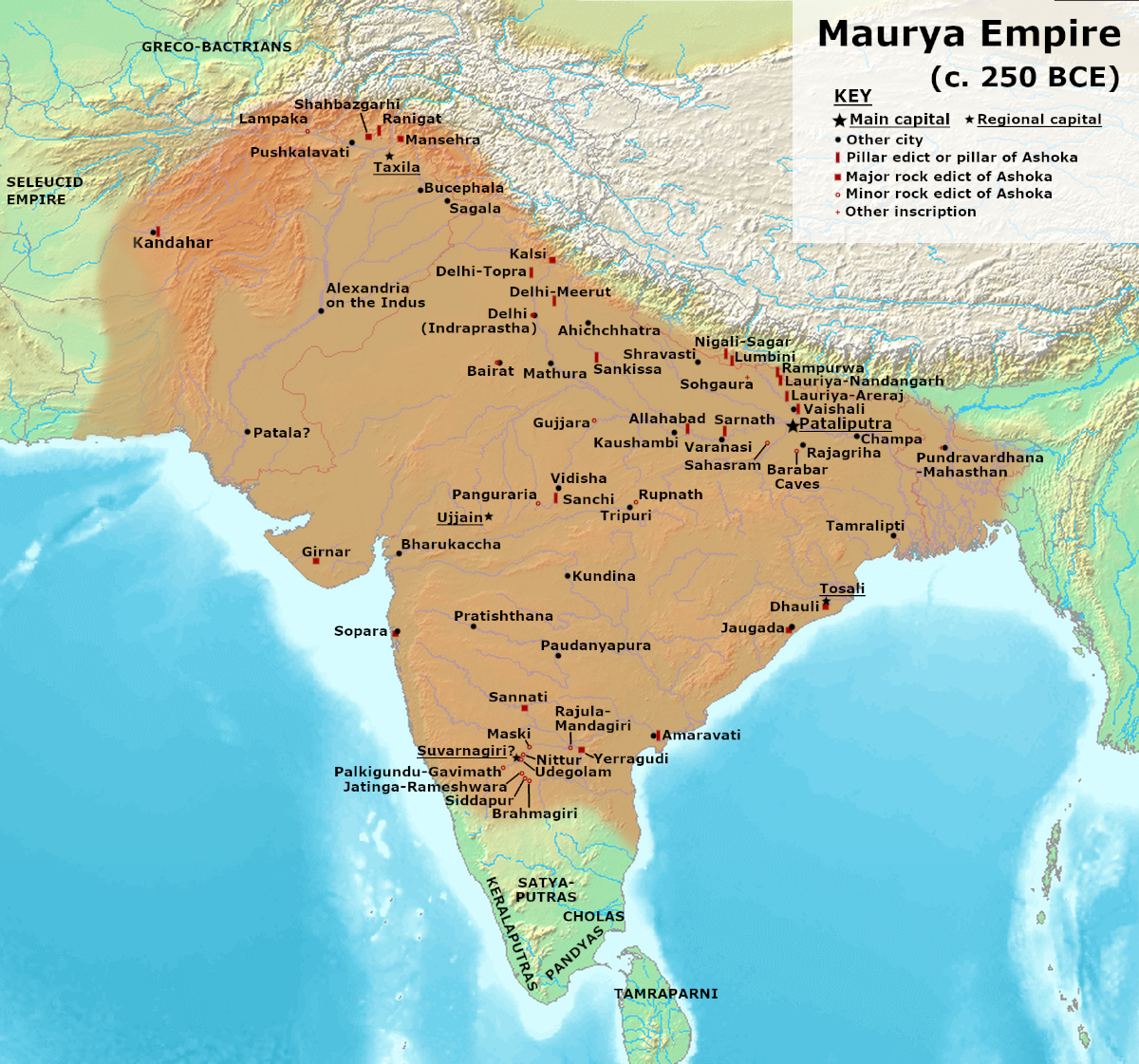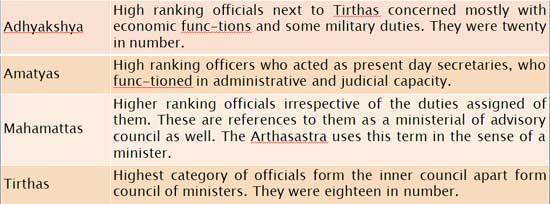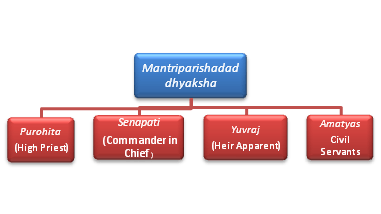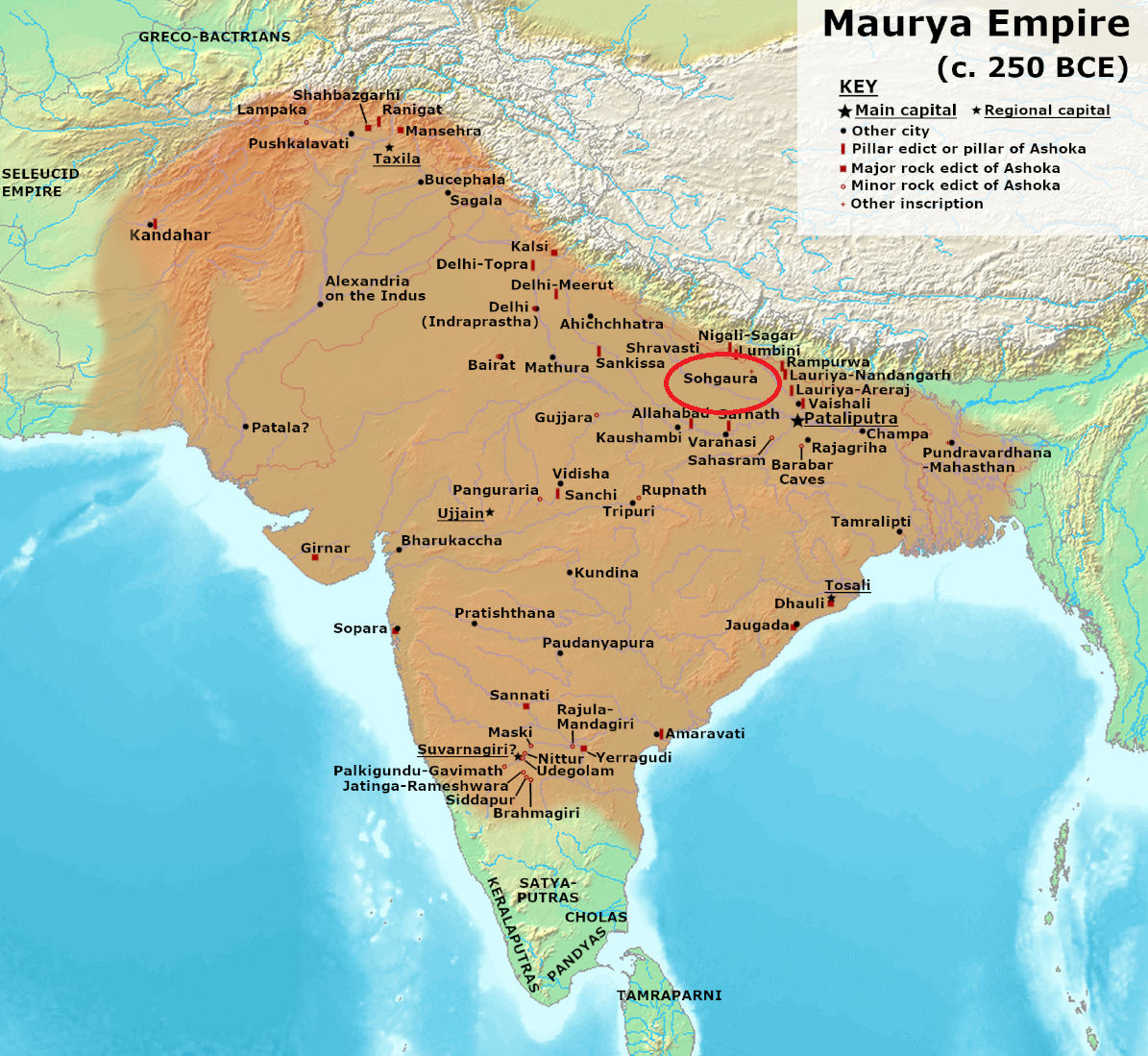The Dec30th Static Quiz on Ancient History (Mauryan)
Quiz-summary
0 of 10 questions completed
Questions:
- 1
- 2
- 3
- 4
- 5
- 6
- 7
- 8
- 9
- 10
Information
The Dec30th Static Quiz on Ancient History (Mauryan)
You have already completed the quiz before. Hence you can not start it again.
Quiz is loading...
You must sign in or sign up to start the quiz.
You have to finish following quiz, to start this quiz:
Results
0 of 10 questions answered correctly
Your time:
Time has elapsed
You have reached 0 of 0 points, (0)
Categories
- Not categorized 0%
- 1
- 2
- 3
- 4
- 5
- 6
- 7
- 8
- 9
- 10
- Answered
- Review
- Question 1 of 10
1. Question
Which of the following statements regarding Mauryan Empire are correct?
1. The Maurya Empire was a geographically extensive copper Age historical power based in Magadha and founded by Chandragupta Maurya, which dominated the Indian subcontinent.
2. Comprising the majority of South Asia, the Maurya Empire was centralized by the conquest of the Indo-Gangetic Plain, and its capital city was located at Pataliputra.CorrectAns;- b) Only 2
Explanation;-
• The 1st statement is incorrect because its not copper age its Iron age.About Mauryan Empire
• The Maurya Empire was a geographically extensive Iron Age historical power based in Magadha and founded by Chandragupta Maurya, which dominated the Indian subcontinent between 322 and 185 BCE.
• The Mauryan Empire was spread out between 4 provinces; Tosali, Ujjain, Suvarnagiri, and Taxila.
• Their Empire was considered a Monarchy and had both a working army and civil service.
• They used a bureaucratic system for economy.
• Comprising the majority of South Asia, the Maurya Empire was centralized by the conquest of the Indo-Gangetic Plain, and its capital city was located at Pataliputra (modern Patna).
• The empire was the largest political entity that has existed in the Indian subcontinent, extending over 5 million square kilometres (1.9 million square miles) at its zenith under Ashoka. Incorrect
IncorrectAns;- b) Only 2
Explanation;-
• The 1st statement is incorrect because its not copper age its Iron age.About Mauryan Empire
• The Maurya Empire was a geographically extensive Iron Age historical power based in Magadha and founded by Chandragupta Maurya, which dominated the Indian subcontinent between 322 and 185 BCE.
• The Mauryan Empire was spread out between 4 provinces; Tosali, Ujjain, Suvarnagiri, and Taxila.
• Their Empire was considered a Monarchy and had both a working army and civil service.
• They used a bureaucratic system for economy.
• Comprising the majority of South Asia, the Maurya Empire was centralized by the conquest of the Indo-Gangetic Plain, and its capital city was located at Pataliputra (modern Patna).
• The empire was the largest political entity that has existed in the Indian subcontinent, extending over 5 million square kilometres (1.9 million square miles) at its zenith under Ashoka.
- Question 2 of 10
2. Question
Which of the following statements regarding Mauryan Administration are correct?
1. In the highly decentralized administration, King used to select ministers, high officials and established a well-planned system of supervision and inspection.
2. King was assisted by his council of Ministers (Mantriparishahda), which was headed by a mantriparishadadhyakshya.CorrectAns;- b) Only 2
Explanation;-
• The statement 1st is incorrect because it is highly centralized administration not de-centralized.
• Mauryan administration was highly centralized.
• The Emperor was the supreme power and source of all authority.
• He was assisted by a Council of Ministers.
• It was called ‘Mantriparishad’.
• The ministers were called ‘Mantris.’
• The council was headed by ‘mantriparishad-adhyakshya’ akin to the Prime Minister of today.
• Kautilya’s ‘Arthashastra’ mentions about the Duties of Government Superintendents (Adyakshas).
• These Adhyakshas formed a secretariat, which was divided into several departments. Incorrect
IncorrectAns;- b) Only 2
Explanation;-
• The statement 1st is incorrect because it is highly centralized administration not de-centralized.
• Mauryan administration was highly centralized.
• The Emperor was the supreme power and source of all authority.
• He was assisted by a Council of Ministers.
• It was called ‘Mantriparishad’.
• The ministers were called ‘Mantris.’
• The council was headed by ‘mantriparishad-adhyakshya’ akin to the Prime Minister of today.
• Kautilya’s ‘Arthashastra’ mentions about the Duties of Government Superintendents (Adyakshas).
• These Adhyakshas formed a secretariat, which was divided into several departments.
- Question 3 of 10
3. Question
Which of the following terms used in Mauryan Empire Central administration are correctly matched?
1. Tirthas = Subordinate officers responsible for the Empire’s revenue.
2. Mahamattas = High ranking officials almost like present-day secretaries.CorrectAns;- d) None of the above
Explanation;-
• Both the statements are incorrect that’s y answer is D, because Amatyas are High ranking officials almost like present-day secretaries, they had administrative and judicial roles, and Yuktas are Subordinate officers responsible for the Empire’s revenue.Central Government of Mauryan Empire
• Mauryan administration was highly centralized.
• The Emperor was the supreme power and source of all authority.
• He was assisted by a Council of Ministers. It was called ‘Mantriparishad’. The ministers were called ‘Mantris.’
• The council was headed by ‘mantriparishad-adhyakshya’ akin to the Prime Minister of today.
• Tirthas: the Highest category of officials in the administration. There were 18 Tirthas.
• Adhyakshya: Ranked next only to Tirthas. There were 20 Adhyakshyas. They had economic and military functions.
• Mahamattas: Higher ranking officials.
• Amatyas: High ranking officials almost like present-day secretaries. They had administrative and judicial roles.
• The Adhyakshyas were formed into a secretariat, which was divided into many departments.
• Arthashastra mentions many Adhyakshyas for commerce, storehouses, gold, ships, agriculture, cows, horses, city, chariots, mint, infantry, etc.
• Yuktas: Subordinate officers responsible for the Empire’s revenue.
• Rajjukas: Officers in charge of land measurement and boundary-fixing.
• Sansthadhyasksha: Superintendent of mint
• Samasthadhyasksha: Superintendent of markets
• Sulkaadhyaksha: Superintendent of tolls
• Sitaadhyaksha: Superintendent of agriculture
• Navadhyaksha: Superintendent of ships
• Lohadhyaksha: Superintendent of iron
• Pauthavadhyakhsa: Superintendent of weights and measures
• Akaradhyaksha: Superintendent of mines
• Vyavharika Mahamatta: Judiciary officers
• Pulisanj: Public relations officers
• Registration of births and deaths, foreigners, industries, trade, manufacture and sale of goods, sales tax collection were under the administration’s control.IncorrectAns;- d) None of the above
Explanation;-
• Both the statements are incorrect that’s y answer is D, because Amatyas are High ranking officials almost like present-day secretaries, they had administrative and judicial roles, and Yuktas are Subordinate officers responsible for the Empire’s revenue.Central Government of Mauryan Empire
• Mauryan administration was highly centralized.
• The Emperor was the supreme power and source of all authority.
• He was assisted by a Council of Ministers. It was called ‘Mantriparishad’. The ministers were called ‘Mantris.’
• The council was headed by ‘mantriparishad-adhyakshya’ akin to the Prime Minister of today.
• Tirthas: the Highest category of officials in the administration. There were 18 Tirthas.
• Adhyakshya: Ranked next only to Tirthas. There were 20 Adhyakshyas. They had economic and military functions.
• Mahamattas: Higher ranking officials.
• Amatyas: High ranking officials almost like present-day secretaries. They had administrative and judicial roles.
• The Adhyakshyas were formed into a secretariat, which was divided into many departments.
• Arthashastra mentions many Adhyakshyas for commerce, storehouses, gold, ships, agriculture, cows, horses, city, chariots, mint, infantry, etc.
• Yuktas: Subordinate officers responsible for the Empire’s revenue.
• Rajjukas: Officers in charge of land measurement and boundary-fixing.
• Sansthadhyasksha: Superintendent of mint
• Samasthadhyasksha: Superintendent of markets
• Sulkaadhyaksha: Superintendent of tolls
• Sitaadhyaksha: Superintendent of agriculture
• Navadhyaksha: Superintendent of ships
• Lohadhyaksha: Superintendent of iron
• Pauthavadhyakhsa: Superintendent of weights and measures
• Akaradhyaksha: Superintendent of mines
• Vyavharika Mahamatta: Judiciary officers
• Pulisanj: Public relations officers
• Registration of births and deaths, foreigners, industries, trade, manufacture and sale of goods, sales tax collection were under the administration’s control. - Question 4 of 10
4. Question
Which of the following were part of Mauryan Mantriparishad?
1. Purohita
2. Senapati
3. Yuvaraj
4. AmatyasCorrectAns;- d) All of the above
Explanation;-
• All above are part of Mauryan Mantriparishad.
• The Arthashastra refers to the highest functionaries at the centre as the eighteen Tirthas, the chief among them were the Mantrin (chief minister), Purohita (high priest), Yuvaraja (heir-apparent), and Senapati (commander-inchief).
• There were various other officials who were in charge of important portfolios. Incorrect
IncorrectAns;- d) All of the above
Explanation;-
• All above are part of Mauryan Mantriparishad.
• The Arthashastra refers to the highest functionaries at the centre as the eighteen Tirthas, the chief among them were the Mantrin (chief minister), Purohita (high priest), Yuvaraja (heir-apparent), and Senapati (commander-inchief).
• There were various other officials who were in charge of important portfolios.
- Question 5 of 10
5. Question
Which of the following terms used in Mauryan Local Administration are correctly matched?
1. Sthanika = Governors of forts.
2. Antapala = Tax collectors working under Pradeshikas.CorrectAns;- d) None of the above
Explanation;-
• Both are wrong, Durgapala was Governors of forts, Sthanika was the tax collectors working under Pradeshikas.Local Administration of Mauryan
• The smallest unit of administration was the village.
• Head of a village: Gramika Villages had a lot of autonomy.
• Pradeshika was the provincial governors or district magistrates.
• Sthanika: Tax collectors working under Pradeshikas.
• Durgapala: Governors of forts.
• Antapala: Governors of frontiers.
• Akshapatala: Accountant General
• Lipikaras: ScribesIncorrectAns;- d) None of the above
Explanation;-
• Both are wrong, Durgapala was Governors of forts, Sthanika was the tax collectors working under Pradeshikas.Local Administration of Mauryan
• The smallest unit of administration was the village.
• Head of a village: Gramika Villages had a lot of autonomy.
• Pradeshika was the provincial governors or district magistrates.
• Sthanika: Tax collectors working under Pradeshikas.
• Durgapala: Governors of forts.
• Antapala: Governors of frontiers.
• Akshapatala: Accountant General
• Lipikaras: Scribes - Question 6 of 10
6. Question
Which of the following terms regarding Mauryan Revenue Administration are correctly matched?
1. Samharta= he was the treasurer
2. Sannidhata = The revenue department chiefCorrectAns;-d) None of the above
Explanation;-
• Both the terms are reversed.
Revenue of Mauryan Administration
• The revenue department chief was called Samharta.
• Another important official was Sannidhata (treasurer).
• Revenue was collected on land, irrigation, shops, customs, forests, ferry, mines and pastures. License fees were collected from artisans and fines were charged in the law courts.
• Most of the land revenue was one-sixth of the produce.IncorrectAns;-d) None of the above
Explanation;-
• Both the terms are reversed.
Revenue of Mauryan Administration
• The revenue department chief was called Samharta.
• Another important official was Sannidhata (treasurer).
• Revenue was collected on land, irrigation, shops, customs, forests, ferry, mines and pastures. License fees were collected from artisans and fines were charged in the law courts.
• Most of the land revenue was one-sixth of the produce. - Question 7 of 10
7. Question
Which of the following statements regarding Mauryan Espionage are correct?
1. The espionage system of the Mauryas was not well-developed.
2. There were two types of spies i.e. Sansthana and SanchariCorrectAns;- b) Only 2
Explanation;-
• The 1st statement is incorrect because Mauryan Espionage system was well developed.
Espionage system of Mauryans
• The espionage system of the Mauryas was well-developed.
• There were spies who informed the Emperor about the bureaucracy and markets.
• There were two types of spies: Sansthana (stationary) and Sanchari (wanderer).
• Gudhapurushas were the detectives or secret agents.
• They were controlled by the Mahamatyapasarpa.
• These agents were picked from different segments of society.
• There were also agents called Vishakanyas (poisonous girls).IncorrectAns;- b) Only 2
Explanation;-
• The 1st statement is incorrect because Mauryan Espionage system was well developed.
Espionage system of Mauryans
• The espionage system of the Mauryas was well-developed.
• There were spies who informed the Emperor about the bureaucracy and markets.
• There were two types of spies: Sansthana (stationary) and Sanchari (wanderer).
• Gudhapurushas were the detectives or secret agents.
• They were controlled by the Mahamatyapasarpa.
• These agents were picked from different segments of society.
• There were also agents called Vishakanyas (poisonous girls). - Question 8 of 10
8. Question
Which of the following statements regarding reasons of Mauryan decline are correct?
1. The successors of Asoka were weak rulers and they appeared to not been able to handle the highly de-centralized tradition of domestic policy of the early Mauryas.
2. Brahminical revolution was a reason of declineCorrectExplanation;-
• The statement 1st is incorrect because it is highly centralized not de-centralized.
• There are several reasons of declining of the Mauryan Dynasty. Some of them are as follows:-
1. Immediately after the death of Asoka, the Mauryan dynasty was partitioned into two parts viz. east and west. This partition disturbed the unity of the empire.
2. The successors of Asoka were weak rulers and they appeared to not been able to handle the highly centralized tradition of domestic policy of the early Mauryas.
3. Some scholars say that pious policy of Asoka was responsible to the decline of the empire as it undermined the strength of the empire.
4. This theory is contradicted by some scholars because Asoka only left policy of annexation but never dissolved or weakened his army.
5. Some scholars say that a Brahminical revolution was a reason of decline; however it is not accepted because Asoka, though patronized Buddhism, but never forced his religion on others.
6. Some scholars say that there was a pressure on Mauryan economy, which is evident from the low quality punch marked coins in the later Maurya period. However, this idea is not adopted because foreign accounts give details of a flourished economy.
7. Some scholars such as Romila Thapar say that Mauryan administration was highly centralized and only a prudent ruler could handle this machinery.
8. Some scholars hold the oppressive policy of the later Mauryan for decline of the empire.IncorrectExplanation;-
• The statement 1st is incorrect because it is highly centralized not de-centralized.
• There are several reasons of declining of the Mauryan Dynasty. Some of them are as follows:-
1. Immediately after the death of Asoka, the Mauryan dynasty was partitioned into two parts viz. east and west. This partition disturbed the unity of the empire.
2. The successors of Asoka were weak rulers and they appeared to not been able to handle the highly centralized tradition of domestic policy of the early Mauryas.
3. Some scholars say that pious policy of Asoka was responsible to the decline of the empire as it undermined the strength of the empire.
4. This theory is contradicted by some scholars because Asoka only left policy of annexation but never dissolved or weakened his army.
5. Some scholars say that a Brahminical revolution was a reason of decline; however it is not accepted because Asoka, though patronized Buddhism, but never forced his religion on others.
6. Some scholars say that there was a pressure on Mauryan economy, which is evident from the low quality punch marked coins in the later Maurya period. However, this idea is not adopted because foreign accounts give details of a flourished economy.
7. Some scholars such as Romila Thapar say that Mauryan administration was highly centralized and only a prudent ruler could handle this machinery.
8. Some scholars hold the oppressive policy of the later Mauryan for decline of the empire. - Question 9 of 10
9. Question
Which one of the following is Mauryan Site? (UPSC 2019 pre)
CorrectAns;- c) Sohagaura
Explanation;-
• Except c all are Harappan sites, C is Mauryan Site.
• The Sohgaura copper plate inscription is an Indian copper plate inscription written in Prakrit in the Brahmi script. It was discovered in Sohgaura, a village on the banks of the Rapti River, about 20 km south-east of Gorakhpur, in the Gorakhpur District, Uttar Pradesh, India.
• The plate, consisting of a line of symbolic drawings and four lines of text, is the result of a molding.
• The inscription is sometimes presented as pre-Ashokan, even pre-Mauryan, but the writing of the plate, especially the configuration of akshara would rather suggest a date after Ashoka. Incorrect
IncorrectAns;- c) Sohagaura
Explanation;-
• Except c all are Harappan sites, C is Mauryan Site.
• The Sohgaura copper plate inscription is an Indian copper plate inscription written in Prakrit in the Brahmi script. It was discovered in Sohgaura, a village on the banks of the Rapti River, about 20 km south-east of Gorakhpur, in the Gorakhpur District, Uttar Pradesh, India.
• The plate, consisting of a line of symbolic drawings and four lines of text, is the result of a molding.
• The inscription is sometimes presented as pre-Ashokan, even pre-Mauryan, but the writing of the plate, especially the configuration of akshara would rather suggest a date after Ashoka.
- Question 10 of 10
10. Question
Consider the following statements regarding guilds during Post-Mauryan period
1. They worked under the government
2. They sometimes issued coins
3. They provided credit and loans to the members of the guild
4. Guild laws were protected by the governmentWhich of the above statements is/are correct?
CorrectAns;- b)Only 2, 3 and 4
Explanation:-
• Merchants and artisans in same business organized themselves into guilds which were independent of government’s interference in its general working.
IncorrectAns;- b)Only 2, 3 and 4
Explanation:-
• Merchants and artisans in same business organized themselves into guilds which were independent of government’s interference in its general working.







